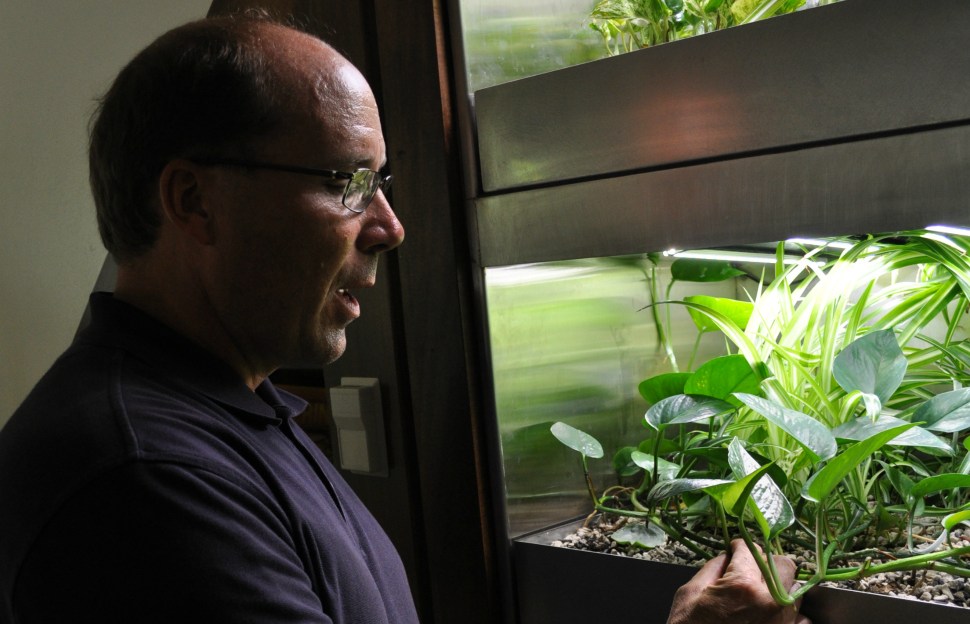Betsy Piland, May 5, 2017
Look at any new housing development and you?ll be hard pressed to find one that doesn?t brag about how ?energy efficient? it is.
This movement is great for energy consumption and costs, but not quite for the air inside the home. Energy efficient homes are very well insulated, keeping heating and cooling costs low, but they also trap and accumulate volatile organic compounds (VOCs) like carbon dioxide.
A model of a thriving green wall of plants called the BioWall could be the solution.
In a recent presentation about the BioWall, Purdue student Scott Massey explained that while there have been many advances in HVAC efficiency and reducing power consumption, the interiors of homes and offices have suffered.
?Unfortunately this has been horrible for interior air quality,? he said. ?In fact, the World Health Organization has named this as one of the biggest causes of future health problems for Americans,.? Massey is part of the team working on the innovative BioWall system, led by Purdue professor Bill Hutzel.
With origins in Purdue?s 2011 Solar Decathlon and borrowing from NASA technology, the BioWall functions as a botanical air filter. ?In a controlled chamber, they?ve seen upwards of 90 percentiles for VOC removal rates,? Massey said of the BioWall. Think back to elementary school science class and you?ll recall that plants take in carbon dioxide, process it through photosynthesis, and then give off oxygen.
The BioWall is built into a home or building and contains trays of plants that make up a plant care and air filtration system. It's a fairly sophisticated system even beyond the air filtering function with watering, light, and airflow all automated. ?Our system knows when to turn itself on and off. The day-to-day maintenance to a homeowner is minimal,? says Hutzel.
?While it does reduce the need for outside air, it?s not a big enough savings that it's going to pay for itself. There's the potential for savings but nobody is going to buy it purely as an energy saving device.? Hutzel said, ?It's the combination of energy savings, potentially better indoor air quality, and the overall aesthetic [that make the BioWall an attractive feature for homes]. People that enjoy plants really seem to respond to that kind of environment.?
The BioWall in West Lafayette, Indiana contains hardy varieties like spider plants, philodendron, and English ivy, but Hutzel?s current students are branching out beyond houseplants and experimenting with kale. The thought is that someday, if there are BioWalls in people?s homes, they can modify trays of plants seasonally to fit time of year and decor.
What began as purely a tech project, quickly became more multidisciplinary than Hutzel ever anticipated. Hutzel?s work is usually so mechanical, full of sensors, controls, and machines. But the BioWall added a big biological component. ?It's been a lot of fun,? he says.
Teams of students from across Purdue?s campus added a touch of their expertise to the BioWall–technology, engineering, agriculture, biochemistry, horticulture, and interior design.
Originally the BioWall was functional but not necessarily something so attractive you?d want it featured in your house. ?We partnered with interior design students to orient it so it's aesthetically pleasing. There are all those considerations that I wouldn't necessarily be good at,? said Hutzel.
As for what?s next, Hutzel said that they?re exploring options for licensing agreements with potential partners. Perhaps an HVAC company with a distribution network or one looking to take on BioWall maintenance in homes as an arm of their business. ?We're not 100 percent sure of where we're going,? says Hutzel, ?but the market will dictate what ultimately gets commercialized.?







